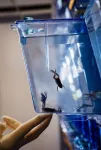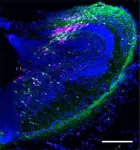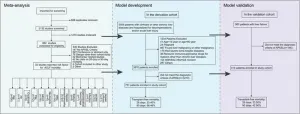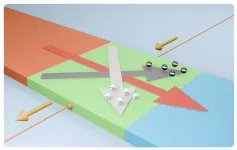(Press-News.org) Amphibians hold a significant place in evolution, representing the transition from aquatic to terrestrial lifestyles. They are crucial for understanding the brain and spinal cord of tetrapods—animals with four limbs, including humans. A group of scientists led by a team at the Institute of Science and Technology Austria (ISTA) now shows how harmless viruses can be used to illuminate the development of the frog nervous system. The results have now been published in Developmental Cell.
Virus. When you hear the word, you probably shudder. But not all viruses are bad or cause disease. Some are even used for therapeutic applications or vaccination. In basic research, they are often employed to infect certain cells, genetically modify them, or visualize neurons in the organism’s central nervous system (CNS)—the command center made up of the brain, spinal cord, and nerves.
The highlighting process now finally works in amphibians. This has been shown in a new study by an international EDGE consortium jointly led by the Sweeney Lab at the Institute of Science and Technology Austria (ISTA) and the Tosches Lab at Columbia University. The researchers established a new technique that uses adeno-associated viruses (AAVs) to track a frog's nervous system throughout its metamorphosis—a developmental transition from the early tadpole stages to its adult form. A breakthrough that can help usher amphibian neurobiology into a new era.
Swimming vs. walking
David Vijatovic and Lora Sweeney enter a laboratory full of water tanks. Vijatovic taps on one of them. Inside, a small mottled greenish-brown African clawed frog (Xenopus laevis) appears. Its limbs are prominent, gracefully maneuvering and gripping its surroundings. In another tank, tadpoles are swirling around using simple swimming motions. It is remarkable to think that one transforms into the other.
“Frogs undergo metamorphosis,” Sweeney says, “making them a great model organism for studying the transition between two movement modes—swimming and walking.” A frog’s development spans over 12 to 16 weeks, giving scientists time to study each stage. During these weeks, a frog embryo develops to a young tadpole, a tadpole with two legs, and a young froglet with four legs before reaching the adult stage. “By looking at the several stages of development, we can investigate these locomotive behaviors and the underlying changes in the nervous system,” Vijatovic adds.
Just like an electrical circuit: how frogs are wired
An organism’s nervous system is referred to as the neural circuit because it resembles an electrical circuit. “Nerve cells (neurons) are connected to other neurons, transmitting electrical information. How we behave, what we sense, and how we interact with the world are the product of the way our neurons communicate with each other within these circuits,” explains Sweeney. The critical piece is how the circuit is wired. We know that neurons are connected but which neuron connects to which? Which other cells does a single cell talk to, and what messages does it convey?
To know more about this wiring, researchers have been using viruses, proven to be a powerful tool. Adeno-associated viruses (AAVs) are ideal in that regard. They are non-pathogenic while being able to infect a wide range of cell types, including neurons. AAVs can be modified to glow in bright green fluorescent colors under the microscope as they travel along neurons, whether in retrograde (backward, from the synapse toward the cell body) or anterograde (forward, from the cell body toward the synapse). In other words, AAVs can be used to illuminate the neural circuit from the broadcasting end to the receiving end or vice-versa.
“This is a common technique used in neuroscience, especially in well-studied organisms like mice. For amphibians, it was thought that it could not be done,” says Vijatovic. That was the general belief until now.
The power of scientific collaboration
To make AAV labeling work in amphibians, Sweeney and Vijatovic joined forces with an international team of scientists from Maria Tosches’ group at Columbia University, where the study’s other two co-first authors Eliza Jaeger and Astrid Deryckere are based. The consortium also included researchers from Tel Aviv University, the University of Utah, the Scripps Research Institute, and the California Institute of Technology. The researchers put their heads together, drew expertise from each other, visited conferences, had countless Zoom calls, and came up with different perspectives and ideas. “When you start researching an organism that is not yet well understood, it is great to have a community where you can share information,” says Sweeney.
They screened existing AAVs to find what was suitable for amphibians and optimized the infecting strategy eventually developing a “how-to guide” for frogs and newts. Vijatovic summarizes his PhD journey, “We started with young tadpoles, made our way to older tadpoles, and finally moved to juvenile and then adult frogs as well as adult newts. We tailored the tool to each life stage.”
Comparing frogs to humans: what this research says about us
With this new technique, the scientists managed to apply AAVs for tracing neuron connections in amphibians. This will help them find out more about how the amphibian brain compares to that of mammals. Besides that, the new approach also opens doors to further analyzing neuronal development. With some of the screened AAV variants, the researchers can label progenitor cells at a specific point in time during the circuit’s development and follow them to see what neurons they become. “This way, we can resolve the whole circuit by its development, see how it changes over time, and how the whole nervous system is built,” Sweeney says.
Although amphibians and mammals last shared a common ancestor about 360 million years ago, they share common traits. “By comparing the details of a frog’s nervous system to a human's, we can see what we don’t have and what we have,” Sweeney continues. This knowledge can help us understand how the human nervous system became specialized over time. “The better we understand the basic building blocks of the nervous system, the more we understand how we can replace them during disease and injury.”
-
Information on animal studies
In order to better understand fundamental processes, for example, in the fields of neuroscience, immunology, or genetics, the use of animals in research is indispensable. No other methods, such as in silico models, can serve as alternative. The animals are raised, kept, and treated according to the strict regulations of Austrian law. All animal procedures are approved by the Federal Ministry of Education, Science and Research.
END
New era in amphibian biology
ISTA scientists use harmless viruses to investigate the nervous system in frogs
2024-11-26
ELSE PRESS RELEASES FROM THIS DATE:
Harbor service, VAST Data provide boost for NCSA systems
2024-11-26
The National Center for Supercomputing Applications and VAST Data are giving supercomputing system Delta and the newly launched DeltaAI a boost in their storage and application performance.
NCSA launched Harbor, a service that provides very fast storage for global home and software directories across all NCSA open-science resources. Its deployment has led to a 400% increase in application launch performance for the Delta system, among many other gains.
Over the last two years, we’ve seen a significant increase in ...
New prognostic model enhances survival prediction in liver failure
2024-11-26
Researchers have unveiled a groundbreaking advancement in liver failure care: the CATCH-LIFE-MELD score (Chinese Acute-on-Chronic Liver Failure Consortium (CATCH-LIFE)-MELD score). This innovative tool, developed by an international team led by Xia Yu and colleagues, enhances the accuracy of predicting short-term survival outcomes for patients suffering from acute-on-chronic liver failure (ACLF). The study, published in eGastroenterology, promises to revolutionize patient management and treatment planning for this life-threatening condition.
“ACLF presents unique challenges due to its rapid progression and high mortality rates,” said Dr. Yu Shi, senior researcher at Zhejiang University ...
China focuses on improving air quality via the coordinated control of fine particles and ozone
2024-11-26
A recent special issue of the journal Atmospheric and Oceanic Science Letters has brought together some of China's top scientists to provide a picture of the latest progress in understanding and controlling air pollution.
Fine particulate matter, referred to as PM2.5, and ground-level ozone (O3) are the main pollutants degrading the air quality of China’s cities and wider urban regions. Both have serious human health effects, such as heart disease, asthma, and lung damage.
The World Health Organization (WHO) provides clear guidelines regarding acceptable concentrations ...
Machine learning reveals behaviors linked with early Alzheimer’s, points to new treatments
2024-11-26
SAN FRANCISCO—November 26, 2024—Subtle signs of Alzheimer’s disease can emerge decades before a diagnosis—often in the form of irregular behaviors that reflect very early stages of brain dysfunction.
But until now, identifying and measuring these slight behavioral changes in a scientific way hasn’t been feasible, not even when studying Alzheimer’s in mice.
In a study published in Cell Reports, a team of scientists at Gladstone Institutes used a new video-based machine learning tool to pinpoint ...
Novel gene therapy trial for sickle cell disease launches
2024-11-26
UCSF Benioff Children's Hospital Oakland is enrolling patients in an innovative clinical trial that seeks to cure sickle cell disease. The trial is the first in the U.S. to apply non-viral CRISPR-Cas9 gene-editing technology in humans to directly correct the genetic mutation that causes the disease.
The research involves taking the patient’s blood stem cells to correct the mutation and returning those edited cells to the patient through a bone marrow transplant. It’s hoped the corrected blood stem cells will then multiply and create a new blood system, one free of sickle cell.
“This ...
Engineering hypoallergenic cats
2024-11-26
Gene editing could create hypoallergenic cats, according to a sequence analysis of the protein that triggers allergies to cats. Some 15% of people are allergic to cats, and symptoms can be severe. Martin D. Chapman and colleagues investigated CH1 and CH2, genes that code for the allergen, Fel d 1. Cats produce Fel d 1 in their sebaceous, salivary, perianal, and lachrymal glands. The function of Fel d 1 is unknown but comparisons of Fel d 1 sequences and homologs from 276 domestic or exotic cats—including cougars, cheetahs, lions, tigers, and jaguars, among others—suggests that CH1 and CH2 have been under active selection, and ...
Microwave-induced pyrolysis: A promising solution for recycling electric cables
2024-11-26
The demand for electronics has led to a significant increase in e-waste. In 2022, approximately 62 million tons of e-waste were generated, marking an 82% increase from 2010. Projections indicate that this figure could rise to 82 million tons by 2030. E-waste contains valuable materials such as metals, semiconductors, and rare elements that can be reused. However, in 2022, only 22.3% of e-waste was properly collected and recycled, while the remaining materials, estimated to be worth almost $62 billion, were discarded in landfills. Although efforts to improve e-waste recycling continue, the process remains labor-intensive, and a significant portion of e-waste ...
Cooling with light: Exploring optical cooling in semiconductor quantum dots
2024-11-26
Cooling systems are an integral part of many modern technologies, as heat tends to wear down materials and decrease performance in several ways. In many cases, however, cooling can be an inconvenient and energy-intensive process. Accordingly, scientists have been seeking innovative and efficient methods to cool substances down.
Solid-state optical cooling is a prominent example that leverages a very unique phenomenon called anti-Stokes (AS) emission. Usually, when materials absorb photons from incoming light, their electrons transition into an “excited” state. Under ideal conditions, as electrons return to their original ...
Breakthrough in clean energy: Scientists pioneer novel heat-to-electricity conversion
2024-11-26
Thermoelectric materials, which convert heat into electricity, are valuable tools for capturing waste heat and turning it into usable electricity. These materials are especially useful in industries and vehicles where engines produce a lot of waste heat, improving energy efficiency by converting it into additional power. They also exhibit potential for portable power generation, in remote sensors and satellites where traditional power sources may be impractical.
Traditional thermoelectric devices, known as parallel thermoelectric devices, generate a voltage in the same direction as the heat ...
Study finds opposing effects of short-term and continuous noise on western bluebird parental care
2024-11-26
Recent research led by Kerstin Ozkan and published in PeerJ Life and Environment has uncovered the complex and contrasting effects of human-generated noise on Western Bluebird (Sialia mexicana) parental behavior, raising critical questions about how anthropogenic noise affects wildlife in both urban and non-urban settings. The study, titled “Divergent effects of short-term and continuous anthropogenic noise exposure on Western Bluebird parental care behavior,” explores how different types of noise exposure alter the bird's ...
LAST 30 PRESS RELEASES:
New software sheds light on cancer’s hidden genetic networks
UT Health San Antonio awarded $3 million in CPRIT grants to bolster cancer research and prevention efforts in South Texas
Third symposium spotlights global challenge of new contaminants in China’s fight against pollution
From straw to soil harmony: International team reveals how biochar supercharges carbon-smart farming
Myeloma: How AI is redrawing the map of cancer care
Manhattan E. Charurat, Ph.D., MHS invested as the Homer and Martha Gudelsky Distinguished Professor in Medicine at the University of Maryland School of Medicine
Insilico Medicine’s Pharma.AI Q4 Winter Launch Recap: Revolutionizing drug discovery with cutting-edge AI innovations, accelerating the path to pharmaceutical superintelligence
Nanoplastics have diet-dependent impacts on digestive system health
Brain neuron death occurs throughout life and increases with age, a natural human protein drug may halt neuron death in Alzheimer’s disease
SPIE and CLP announce the recipients of the 2025 Advanced Photonics Young Innovator Award
Lessons from the Caldor Fire’s Christmas Valley ‘Miracle’
Ant societies rose by trading individual protection for collective power
Research reveals how ancient viral DNA shapes early embryonic development
A molecular gatekeeper that controls protein synthesis
New ‘cloaking device’ concept to shield sensitive tech from magnetic fields
Researchers show impact of mountain building and climate change on alpine biodiversity
Study models the transition from Neanderthals to modern humans in Europe
University of Phoenix College of Doctoral Studies releases white paper on AI-driven skilling to reduce burnout and restore worker autonomy
AIs fail at the game of visual “telephone”
The levers for a sustainable food system
Potential changes in US homelessness by ending federal support for housing first programs
Vulnerability of large language models to prompt injection when providing medical advice
Researchers develop new system for high-energy-density, long-life, multi-electron transfer bromine-based flow batteries
Ending federal support for housing first programs could increase U.S. homelessness by 5% in one year, new JAMA study finds
New research uncovers molecular ‘safety switch’ shielding cancers from immune attack
Bacteria resisting viral infection can still sink carbon to ocean floor
Younger biological age may increase depression risk in older women during COVID-19
Bharat Innovates 2026 National Basecamp Showcases India’s Most Promising Deep-Tech Ventures
Here’s what determines whether your income level rises or falls
SCIE indexation achievement: Celebrate with Space: Science & Technology
[Press-News.org] New era in amphibian biologyISTA scientists use harmless viruses to investigate the nervous system in frogs








